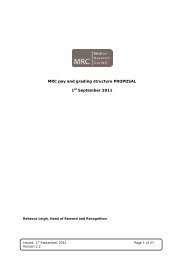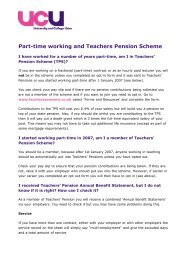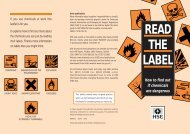bullying and harassment at work - UCU
bullying and harassment at work - UCU
bullying and harassment at work - UCU
- No tags were found...
You also want an ePaper? Increase the reach of your titles
YUMPU automatically turns print PDFs into web optimized ePapers that Google loves.
ullying<strong>and</strong><strong>harassment</strong><strong>at</strong> <strong>work</strong>A toolkit for <strong>UCU</strong> branch <strong>and</strong>LA officersIncluding health <strong>and</strong>safety represent<strong>at</strong>ives<strong>and</strong> equality officers
ContentsIntroduction . . . . . . . . . . . . . . . . . . . . . . . . . . . . . . . . . . . . . . . . . . . . . . . . . . . . . . . . . . . . . 1A duty of care . . . . . . . . . . . . . . . . . . . . . . . . . . . . . . . . . . . . . . . . . . . . . . . . . . . . . . . . . . . . . . 1A real problem in educ<strong>at</strong>ion . . . . . . . . . . . . . . . . . . . . . . . . . . . . . . . . . . . . . . . . . . . . . . . . . . . 1A collective problem not just an individual one . . . . . . . . . . . . . . . . . . . . . . . . . . . . . . . . . . . 1The purpose of this guide. . . . . . . . . . . . . . . . . . . . . . . . . . . . . . . . . . . . . . . . . . . . . . . . . . . . . 2Section 1: Wh<strong>at</strong> is <strong>work</strong>place <strong>bullying</strong> <strong>and</strong> <strong>harassment</strong>? . . . . . . . . . . . . . . . . . . . . . . . 3Identifying <strong>bullying</strong> <strong>and</strong> <strong>harassment</strong> . . . . . . . . . . . . . . . . . . . . . . . . . . . . . . . . . . . . . . . . . . . . 3Effects in the <strong>work</strong>place . . . . . . . . . . . . . . . . . . . . . . . . . . . . . . . . . . . . . . . . . . . . . . . . . . . . . . 4The legal frame<strong>work</strong> . . . . . . . . . . . . . . . . . . . . . . . . . . . . . . . . . . . . . . . . . . . . . . . . . . . . . . . . . 6A collective <strong>and</strong> institutional issue . . . . . . . . . . . . . . . . . . . . . . . . . . . . . . . . . . . . . . . . . . . . . 7A health <strong>and</strong> safety issue . . . . . . . . . . . . . . . . . . . . . . . . . . . . . . . . . . . . . . . . . . . . . . . . . . . . . 8Wh<strong>at</strong> to do if you are being bullied or harassed. . . . . . . . . . . . . . . . . . . . . . . . . . . . . . . . . . 10Wh<strong>at</strong> to do if you witness <strong>bullying</strong> or <strong>harassment</strong> . . . . . . . . . . . . . . . . . . . . . . . . . . . . . . . . 12Guidance for those accused of <strong>bullying</strong> or <strong>harassment</strong> . . . . . . . . . . . . . . . . . . . . . . . . . . . 12The real face of <strong>bullying</strong> . . . . . . . . . . . . . . . . . . . . . . . . . . . . . . . . . . . . . . . . . . . . . . . . . . . . . 14Section2: Action for branches <strong>and</strong> local associ<strong>at</strong>ions . . . . . . . . . . . . . . . . . . . . . . . . . 15Policy <strong>and</strong> procedures . . . . . . . . . . . . . . . . . . . . . . . . . . . . . . . . . . . . . . . . . . . . . . . . . . . . . . 15Publicity. . . . . . . . . . . . . . . . . . . . . . . . . . . . . . . . . . . . . . . . . . . . . . . . . . . . . . . . . . . . . . . . . . 15A <strong>bullying</strong> <strong>and</strong> <strong>harassment</strong> policy . . . . . . . . . . . . . . . . . . . . . . . . . . . . . . . . . . . . . . . . . . . . . 16Secton 3: Tools <strong>and</strong> resources . . . . . . . . . . . . . . . . . . . . . . . . . . . . . . . . . . . . . . . . . . . . . 21Interviewing a member - a checklist for union reps . . . . . . . . . . . . . . . . . . . . . . . . . . . . . . . 22Model letter. . . . . . . . . . . . . . . . . . . . . . . . . . . . . . . . . . . . . . . . . . . . . . . . . . . . . . . . . . . . . . . 23Model leaflet: Am I being bullied? . . . . . . . . . . . . . . . . . . . . . . . . . . . . . . . . . . . . . . . . . . . . . 24Model survey. . . . . . . . . . . . . . . . . . . . . . . . . . . . . . . . . . . . . . . . . . . . . . . . . . . . . . . . . . . . . . 25Model policy . . . . . . . . . . . . . . . . . . . . . . . . . . . . . . . . . . . . . . . . . . . . . . . . . . . . . . . . . . . . . . 28Further inform<strong>at</strong>ion <strong>and</strong> resources . . . . . . . . . . . . . . . . . . . . . . . . . . . . . . . . . . . . . . . . . . . . 28
IntroductionIntroductionA duty of careAll employers have a duty of care to ensure th<strong>at</strong> employees are tre<strong>at</strong>ed fairly <strong>and</strong> to provide asafe <strong>work</strong>ing environment. Colleges <strong>and</strong> universities also have a duty to provide a <strong>work</strong>ingenvironment free of discrimin<strong>at</strong>ion, <strong>and</strong> one where equality is promoted.Where <strong>bullying</strong> <strong>and</strong> <strong>harassment</strong> are allowed or where action is not taken to prevent them,educ<strong>at</strong>ional institutions do more than damage their staff.A culture of <strong>bullying</strong> is also not conducive to good teaching or good research. Bullying <strong>and</strong><strong>harassment</strong> are particularly unacceptable in institutions of learning because staff must beable to question <strong>and</strong> challenge received wisdom <strong>and</strong> to teach students how to do the same.A real problem in educ<strong>at</strong>ionWhen Petra Boynton of University College London surveyed academic staff in 2005 shefound <strong>bullying</strong> to be widespread with many incidents taking place in meetings <strong>and</strong> communalareas, suggesting a culture which condoned <strong>bullying</strong>.In further <strong>and</strong> higher educ<strong>at</strong>ion there is growing evidence th<strong>at</strong> <strong>bullying</strong> <strong>and</strong> <strong>harassment</strong> arewidespread.<strong>UCU</strong>’s own UK-wide survey published in 2007 showed th<strong>at</strong> across both sectors over one thirdof respondents found <strong>bullying</strong> by managers or colleagues to be <strong>at</strong> ‘very stressful‘ levels.A further 2007 survey of <strong>UCU</strong> members by Professor Jeremy Waddington found th<strong>at</strong> the issueof <strong>bullying</strong> <strong>and</strong>/or <strong>harassment</strong> was the single most common concern facing <strong>UCU</strong> members.The <strong>UCU</strong> survey had responses from 4,000 <strong>UCU</strong> members n<strong>at</strong>ionwide, <strong>and</strong> showed th<strong>at</strong> theissues members were most likely to take to branch officers were <strong>bullying</strong> <strong>and</strong> <strong>harassment</strong>.Professor Waddington said this was the only union in which such a survey result hadoccurred.The Health <strong>and</strong> Safety Executive (HSE) estim<strong>at</strong>es th<strong>at</strong> <strong>bullying</strong> is a key element in stressrel<strong>at</strong>ed<strong>work</strong>place illness <strong>and</strong> costs employers many millions of lost days a year. Stressrel<strong>at</strong>edillness <strong>and</strong> absence levels in educ<strong>at</strong>ion are substantially above the n<strong>at</strong>ional average.A collective problem not just an individual oneBullying <strong>and</strong> <strong>harassment</strong> are rarely completely isol<strong>at</strong>ed, one-off events. While <strong>UCU</strong> can <strong>and</strong>must give support to individual members, we will be much more effective if we address theproblem <strong>at</strong> source. Th<strong>at</strong> means looking <strong>at</strong> the institution as a whole to: identify who else is being bullied or harassed ensure your institution has a clear policy in place to prevent <strong>bullying</strong> <strong>and</strong> <strong>harassment</strong> <strong>and</strong>tackle them if they occur <strong>and</strong> th<strong>at</strong> the policy is enforced.1
ullying <strong>and</strong> <strong>harassment</strong> <strong>at</strong> <strong>work</strong>The purpose of this guideThis guide is intended to be useful to all <strong>UCU</strong> members but is especially designed to equiplocal represent<strong>at</strong>ives with the tools to deal with <strong>bullying</strong> <strong>and</strong> <strong>harassment</strong> within your institution.Some universities <strong>and</strong> colleges recognise th<strong>at</strong> <strong>bullying</strong> <strong>and</strong> <strong>harassment</strong> exist <strong>and</strong> areunacceptable, but others remain in denial. We welcome the good practice emerging, butmuch more needs to be done.2
Wh<strong>at</strong> is <strong>work</strong>place <strong>bullying</strong> <strong>and</strong> <strong>harassment</strong>?Section 1Wh<strong>at</strong> is <strong>work</strong>place <strong>bullying</strong> & <strong>harassment</strong>?If you believe th<strong>at</strong> you are being bullied,the chances are, you areBullying can affect staff <strong>at</strong> every level of the institution <strong>and</strong> from all backgrounds. It involves amisuse of power, <strong>and</strong> is usually, but not always, perpetr<strong>at</strong>ed by managers against staff overwhom they have power. It may particularly affect women, disabled, ethnic minority <strong>and</strong> LGBTstaff, <strong>and</strong> can be a form of discrimin<strong>at</strong>ion. Bullying <strong>and</strong> <strong>harassment</strong> are a major danger tostaff health. They are often closely linked, <strong>and</strong> may overlap, but they are legally distinct.The guide tackles both issues together because of the considerable overlap but the differencesmay be important <strong>and</strong> should always be borne in mind.Definition of <strong>harassment</strong>Harassment is unlawful when it is on the grounds of sex, gender reassignment, race, ethnicor n<strong>at</strong>ional origin, sexual orient<strong>at</strong>ion, age, religion or belief, or disability. It is also unlawful tosubject a person to sexual <strong>harassment</strong> (a separ<strong>at</strong>e c<strong>at</strong>egory from <strong>harassment</strong> on thegrounds of sex), or to <strong>harassment</strong> on the grounds of membership or non-membership of <strong>at</strong>rade union, or, in Northern Irel<strong>and</strong>, on the grounds of political belief.The law defines <strong>harassment</strong> as unwanted contact which has the purpose (intentional) oreffect (unintentional) of viol<strong>at</strong>ing a person’s dignity or cre<strong>at</strong>ing an intimid<strong>at</strong>ing, hostile,degrading, humili<strong>at</strong>ing or offensive environment for th<strong>at</strong> person.Definition of <strong>bullying</strong>Bullying may include <strong>harassment</strong> <strong>and</strong> <strong>harassment</strong> may include <strong>bullying</strong>. However there is nost<strong>at</strong>utory definition of <strong>bullying</strong>, which is defined by ACAS (Advisory, Concili<strong>at</strong>ion <strong>and</strong> Arbitr<strong>at</strong>ionService) as behaviour th<strong>at</strong>: is offensive, intimid<strong>at</strong>ing, malicious or insulting is an abuse of power, <strong>and</strong> uses means intended to undermine, humili<strong>at</strong>e, denigr<strong>at</strong>e or injure the recipientWhereas <strong>harassment</strong> is linked, in law, to discrimin<strong>at</strong>ion, <strong>bullying</strong> is not.Identifying <strong>bullying</strong> <strong>and</strong> <strong>harassment</strong>Although there is no comprehensive list of <strong>bullying</strong> behaviours, <strong>and</strong> there is no one type ofperson who is likely to be a bully or a harasser, ACAS lists some of the behaviours whichconstitute <strong>work</strong>place <strong>bullying</strong> <strong>and</strong> <strong>harassment</strong>Examples of <strong>work</strong>place <strong>bullying</strong> <strong>and</strong>/or <strong>harassment</strong> can include: constantly criticising competent staff, removing their responsibilities, or giving them trivialtasks to do shouting <strong>at</strong> staff persistently picking on staff in front of others, or in priv<strong>at</strong>e3
ullying <strong>and</strong> <strong>harassment</strong> <strong>at</strong> <strong>work</strong>obstructing professional development / blocking promotionregularly making the same person the butt of jokesconstantly <strong>at</strong>tacking a member of staff in terms of their professional or personal st<strong>and</strong>ingsetting a person up to fail by overloading them with <strong>work</strong> or setting impossible deadlinesregularly <strong>and</strong> deliber<strong>at</strong>ely ignoring or excluding individuals from <strong>work</strong> activitiesignoring staff views <strong>and</strong> opinionsdifferent rules for different peoplecriticism <strong>and</strong> thre<strong>at</strong>sexcessive monitoringunrealistic expect<strong>at</strong>ionsBullying or <strong>harassment</strong> may be by an individual against another (perhaps by someone in aposition of authority such as a manager or supervisor) or involve groups of people. It may beobvious or it may be subtle - wh<strong>at</strong>ever form it takes, the crucial point is th<strong>at</strong> it is unwarranted<strong>and</strong> unwelcome by the recipient.Effects in the <strong>work</strong>placeFor the employeeWhen <strong>bullying</strong> <strong>and</strong> <strong>harassment</strong> occur they not only affect the complainant but have a knockoneffect for the <strong>work</strong> area or institution in which they are occurring. Rel<strong>at</strong>ionships between<strong>work</strong> colleagues become strained <strong>and</strong> <strong>at</strong> times difficult, with some colleagues not wanting to‘get involved’ as they do not see the <strong>bullying</strong> <strong>and</strong> <strong>harassment</strong> as having anything to do withthem or they themselves may not want to become a target for the perpetr<strong>at</strong>or.The effects on the recipient of <strong>bullying</strong> <strong>and</strong> <strong>harassment</strong> vary from individual to individual.While this list is not exhaustive, it does give an indic<strong>at</strong>ion of the symptoms th<strong>at</strong> may occur:depressionskin complaintsmental health problemssleeplessnesslow self esteem / lack of confidenceacute anxietyloss of appetitepanic <strong>at</strong>tacksfeeling isol<strong>at</strong>ednauseamigraine / severe headachesmood swingsstomach problemsA major survey conducted by the University of Manchester Institute of Science <strong>and</strong> Technologyshowed:The effects of <strong>work</strong>place <strong>bullying</strong> are estim<strong>at</strong>ed to be responsible for between one thirdto a half of all stress rel<strong>at</strong>ed illnesses.One in ten <strong>work</strong>ers had been bullied in the last six months. One in four <strong>work</strong>ers hadbeen bullied in the last five years. 47% of <strong>work</strong>ers had witnessed <strong>bullying</strong> <strong>at</strong> <strong>work</strong>.The main cost of <strong>bullying</strong> is to the individual being bullied. Stress <strong>and</strong> ill health can becomepart of the daily life of those being bullied. But there are major costs to the institution <strong>and</strong> tostudents.4
Wh<strong>at</strong> is <strong>work</strong>place <strong>bullying</strong> <strong>and</strong> <strong>harassment</strong>?For the employerA survey of <strong>UCU</strong> members carried out in March 2007 <strong>at</strong> Leeds Metropolitan Universityrevealed a disturbing culture of individual <strong>and</strong> institutionalised <strong>bullying</strong>. The survey revealedth<strong>at</strong> 68% of members were stressed because of <strong>bullying</strong> <strong>and</strong> 61% suffered <strong>work</strong> rel<strong>at</strong>edhealth concerns.Employers who fail to tackle <strong>bullying</strong> <strong>and</strong> <strong>harassment</strong> undermine their own staff performance<strong>and</strong> may be breaking the law. They need to put in place clear <strong>and</strong> properly implementedpolicies to prevent <strong>bullying</strong> <strong>and</strong> <strong>harassment</strong> <strong>and</strong> deal effectively with it if it neverthelessoccurs.Bullying thrives where it is common behaviour across the management hierarchy – which isthe case in highly competitive environments where many individuals consider <strong>bullying</strong> asthe accepted method of motiv<strong>at</strong>ing staff.‘In organis<strong>at</strong>ions th<strong>at</strong> pride themselves on strong management, <strong>bullying</strong> can soon becomepart of the organis<strong>at</strong>ion‘s culture <strong>and</strong> management will be seen by their employees to havecondoned such behaviour simply through their inaction.‘Source: The Andrea Adams Trust3.6% of salary budgets (n<strong>at</strong>ional average) is paid to people absent from <strong>work</strong> due to stressrel<strong>at</strong>ed illness.Source: Department of HealthFailure to address the issues of <strong>harassment</strong> <strong>and</strong> <strong>bullying</strong> in the <strong>work</strong>place can also haveserious consequences which can include:increased sick absencedemotiv<strong>at</strong>ionincreased absenteeismreduced productivitycostly law suits over stress <strong>and</strong><strong>bullying</strong>high staff turnoverrisk to public image of the institutioncostly retrainingloss of client/customer confidencelow staff morale5
ullying <strong>and</strong> <strong>harassment</strong> <strong>at</strong> <strong>work</strong>The legal frame<strong>work</strong>Proving you have been bullied or harassed <strong>at</strong> <strong>work</strong> is not easy. <strong>UCU</strong> strongly recommends th<strong>at</strong>wherever possible members try to resolve <strong>bullying</strong> <strong>and</strong> <strong>harassment</strong> through negoti<strong>at</strong>ions <strong>and</strong>campaigns <strong>at</strong> <strong>work</strong>, using institutional policies. This summary of potentially relevant law issimply intended as background <strong>and</strong> members are strongly encouraged only to consider legalaction as a last resort.There is no specific UK legisl<strong>at</strong>ion on <strong>work</strong>place <strong>bullying</strong> but a large amount on <strong>harassment</strong>on any of the protected grounds. The following place legal duties on employers <strong>and</strong>employees which should form part of the frame<strong>work</strong> within which institutions draft policies<strong>and</strong> implement them.The Health <strong>and</strong> Safety <strong>at</strong> Work Act 1974 sets out the general duty of care of employerstowards staff <strong>and</strong> the HSE has published regul<strong>at</strong>ions requiring risk assessments <strong>and</strong>management st<strong>and</strong>ards for stress <strong>at</strong> <strong>work</strong>, one of whose main causes is <strong>bullying</strong> <strong>at</strong> <strong>work</strong>.Using these regul<strong>at</strong>ions is discussed in more detail on page 8 of this guide.The Sex Discrimin<strong>at</strong>ion Act 1975 offers protection against unlawful discrimin<strong>at</strong>ion to bothmen <strong>and</strong> women, while the Employment Equality [Sex Discrimin<strong>at</strong>ion] Regul<strong>at</strong>ions 2005give protection against discrimin<strong>at</strong>ion <strong>and</strong> <strong>harassment</strong> on the grounds of a person’s sexor gender re-assignment. Amendments introduced in 2005 produced new definitions ofsexual <strong>harassment</strong>, making it clear th<strong>at</strong> this involves unwanted actions of a sexual n<strong>at</strong>ure.The Gender Equality Duty, brought in by The Equality Act 2006, requires public authorities(including colleges <strong>and</strong> universities) to elimin<strong>at</strong>e unlawful discrimin<strong>at</strong>ion <strong>and</strong> <strong>harassment</strong> The Employment Equality [Sexual Orient<strong>at</strong>ion] Regul<strong>at</strong>ions 2003 became law on 1December 2003 <strong>and</strong> make it unlawful to discrimin<strong>at</strong>e or harass in employment or trainingon the grounds of sexual orient<strong>at</strong>ion. The Equality Act [Sexual Orient<strong>at</strong>ion] Regul<strong>at</strong>ions2007 extended the legisl<strong>at</strong>ion to cover goods <strong>and</strong> services. Lesbians, gay men <strong>and</strong> bisexualsare entitled to protections similar to those provided for women, disabled <strong>and</strong> black<strong>and</strong> ethnic minority staff.The Race Rel<strong>at</strong>ions Act 1976 makes it unlawful to discrimin<strong>at</strong>e against or harass aperson, directly or indirectly on racial grounds in: employment, educ<strong>at</strong>ion, housing; <strong>and</strong> inthe provision of goods, facilities <strong>and</strong> services while The Race Rel<strong>at</strong>ions Act 1976[Amendment] Regul<strong>at</strong>ions 2000 required public authorities (including further <strong>and</strong> highereduc<strong>at</strong>ion institutions) to observe a st<strong>at</strong>utory general duty to elimin<strong>at</strong>e discrimin<strong>at</strong>ion <strong>and</strong>promote race equalityThe Disability Discrimin<strong>at</strong>ion Act 1995 makes it unlawful to discrimin<strong>at</strong>e or harass on thegrounds of disability. The Disability Equality Duty (DED), introduced by the DisabilityDiscrimin<strong>at</strong>ion Act 2005, places a duty on all public sector authorities (including colleges<strong>and</strong> universities) to elimin<strong>at</strong>e discrimin<strong>at</strong>ion <strong>and</strong> <strong>harassment</strong> <strong>and</strong> to promote disabilityequality.The Employment Equality [Religion or Belief] Regul<strong>at</strong>ions 2003 outlaw discrimin<strong>at</strong>ion inemployment <strong>and</strong> voc<strong>at</strong>ional training on the grounds of religion or belief including <strong>harassment</strong>on such grounds. The Equality Act 2006 extended these regul<strong>at</strong>ions to cover goods<strong>and</strong> services.6
Wh<strong>at</strong> is <strong>work</strong>place <strong>bullying</strong> <strong>and</strong> <strong>harassment</strong>?The Employment Equality [Age] Regul<strong>at</strong>ions 2006 outlaw age discrimin<strong>at</strong>ion in employment<strong>and</strong> voc<strong>at</strong>ional training, including <strong>harassment</strong> on the grounds of age.The Protection from Harassment Act 1997 generally prohibits <strong>harassment</strong> but recentcase law has established th<strong>at</strong> there may be very limited circumstances where its provisionsinclude <strong>work</strong>place <strong>harassment</strong>.The Trade Union <strong>and</strong> Labour Rel<strong>at</strong>ions (Consolid<strong>at</strong>ion) Act 1992 gives specific protectionto trade union represent<strong>at</strong>ives who are victimised as a result of trade union activities,which may include challenging <strong>bullying</strong> <strong>and</strong> <strong>harassment</strong>.Don’t <strong>at</strong>tempt to use, or thre<strong>at</strong>en to use, any of these legal sanctions before you havetaken advice from your union represent<strong>at</strong>ive who in turn should seek advice from theirregional office.<strong>UCU</strong> regards all forms of <strong>bullying</strong> as unacceptable whether or not they are unlawful.Your institution’s own anti-<strong>bullying</strong> <strong>and</strong> <strong>harassment</strong> procedures should take the sameapproach.Remember, thre<strong>at</strong>ening to use legal rights may be helpful; relying on them instead oftrying to resolve issues <strong>at</strong> <strong>work</strong> is unwise. The law is, unfortun<strong>at</strong>ely, not very helpful incases of <strong>bullying</strong> though a little more helpful when dealing with <strong>harassment</strong>.The courts continue to be unhelpfulThe legal remedies for someone who has experienced <strong>bullying</strong> <strong>at</strong> <strong>work</strong> are largely ineffective,unless they can <strong>at</strong>tach the claim to a ground of unlawful discrimin<strong>at</strong>ion. Bullying can be abreach of the implied term of trust <strong>and</strong> confidence, but, on the current st<strong>at</strong>e of the law, theemployee cannot base a claim in respect of this breach unless they resign.An employer has a duty <strong>at</strong> common law to take reasonable steps to protect the employeefrom harm to their physical <strong>and</strong> mental health, but this duty is limited to harm which is foreseeable.Trade unions had hoped th<strong>at</strong> the case of Majrowski v Guy’s <strong>and</strong> St Thomas’s NHS Trust,which used the Protection from Harassment Act, might offer a remedy for employees beingbullied <strong>at</strong> <strong>work</strong>. Unfortun<strong>at</strong>ely another case, involving Sunderl<strong>and</strong> City Council in 2006-7,suggests this is unlikely to be of wide use. The Court of Appeal decided th<strong>at</strong> the test of wh<strong>at</strong>constituted ‘<strong>harassment</strong>‘ for the purposes of the Protection from Harassment Act is whetherthe conduct is so serious as to justify the sanctions of the criminal law, a steep test, especiallyas the Act requires more than one such act to be suffered.A collective <strong>and</strong> institutional issueIt is very unusual for <strong>bullying</strong> cases to be a one-off phenomenon. Good policies on preventing<strong>bullying</strong> <strong>and</strong> <strong>harassment</strong> recognise th<strong>at</strong>, <strong>and</strong> regular effective monitoring <strong>and</strong> surveys willgenerally confirm th<strong>at</strong> is the case.Bullying <strong>and</strong> <strong>harassment</strong> arise when the institution does not make it clear th<strong>at</strong> <strong>bullying</strong> <strong>and</strong><strong>harassment</strong> are unacceptable <strong>and</strong> serious offences which can result in disciplinary action.The changing management culture within both further <strong>and</strong> higher educ<strong>at</strong>ion in response to7
ullying <strong>and</strong> <strong>harassment</strong> <strong>at</strong> <strong>work</strong>incorpor<strong>at</strong>ion, the emphasis on ‘performance management‘, the pressure from competitionwith other institutions for resources <strong>and</strong> students, the pressure from external inspections<strong>and</strong> audits, <strong>and</strong> the adoption of an inappropri<strong>at</strong>e governance <strong>and</strong> management culture havecombined to make <strong>bullying</strong> a major concern for staff <strong>and</strong> for <strong>UCU</strong>.The Health <strong>and</strong> Safety Executive identifies <strong>bullying</strong> as a key cause of stress <strong>at</strong> <strong>work</strong> in educ<strong>at</strong>ion.The financial <strong>and</strong> ‘market‘ pressures on colleges <strong>and</strong> universities together with the useof inappropri<strong>at</strong>e management methods place middle managers in particular in a difficultposition where they have to deliver a range of inappropri<strong>at</strong>e or un<strong>at</strong>tainable ‘targets‘ – <strong>and</strong> todo so they are bullied <strong>and</strong> in turn bully their staff.Responding to a stream of individual cases of <strong>bullying</strong> can be an exhausting undertaking for<strong>UCU</strong> reps <strong>and</strong> a frustr<strong>at</strong>ing one for members. It is much more effective to seek to prevent<strong>bullying</strong> by having in place effective, monitored policies th<strong>at</strong> are implemented from the top ofthe institution than by trying to represent an individual member who has already suffered<strong>bullying</strong>. To be effective such policies must include effective means for detecting, recording,reporting <strong>and</strong> dealing with breaches of the policy.Surveys, especially if they are jointly undertaken, can be very useful in establishing the scaleof <strong>bullying</strong> <strong>and</strong> drive action to improve m<strong>at</strong>ters. Advice <strong>and</strong> support could be obtained fromthe Health <strong>and</strong> Safety Executive. The survey could part of a wider survey on stress using theHSE’s stress management tools (see www.hse.gov.uk/stress/index.htm).Moreover where a survey has established <strong>bullying</strong> is a significant problem, it enables <strong>UCU</strong>reps to underpin <strong>and</strong> make more credible individual complaints of <strong>bullying</strong> by arguing theyare part of a wider <strong>bullying</strong> culture.Th<strong>at</strong>’s why <strong>UCU</strong> branches should always try to:Have an effective, agreed, monitored policy on <strong>bullying</strong> <strong>and</strong> <strong>harassment</strong> in place.Ensure a local institutional survey takes place, <strong>and</strong> is repe<strong>at</strong>ed <strong>at</strong> regular intervals (sayevery two years) to establish the scale of <strong>bullying</strong> <strong>and</strong> <strong>harassment</strong>, including ‘hotspots‘.These can help demonstr<strong>at</strong>e the scale of the problem <strong>and</strong> th<strong>at</strong> <strong>bullying</strong> <strong>and</strong> <strong>harassment</strong>is not confined to an individual case.Tre<strong>at</strong> <strong>bullying</strong> as a health <strong>and</strong> safety hazard using ‘risk assessment‘ methods to prevent<strong>and</strong> control it.Ensure the most senior staff in the institution st<strong>at</strong>e clearly their opposition to <strong>bullying</strong><strong>and</strong> <strong>harassment</strong> <strong>and</strong> set a personal example, taking personal responsibility for ensuringthe findings of surveys <strong>and</strong> remedial action are publicised <strong>and</strong> drawn to the <strong>at</strong>tention ofthe governing body <strong>and</strong> effective prevent<strong>at</strong>ive action is taken.A health <strong>and</strong> safety issuePeople who continually undermine, verbally abuse, thre<strong>at</strong>en <strong>and</strong> denigr<strong>at</strong>e those theymanage or <strong>work</strong> with, causing stress <strong>and</strong> other ill health, are a health <strong>and</strong> safety hazard.The Health <strong>and</strong> Safety <strong>at</strong> Work Act 1974 sets out the general duty of care of employerstowards staff <strong>and</strong> the oblig<strong>at</strong>ions employers have towards employees <strong>and</strong> members of thepublic <strong>and</strong> th<strong>at</strong> employees have to themselves <strong>and</strong> to each other. The Management of Health8
Wh<strong>at</strong> is <strong>work</strong>place <strong>bullying</strong> <strong>and</strong> <strong>harassment</strong>?<strong>and</strong> Safety <strong>at</strong> Work Regul<strong>at</strong>ions 1999 require employers to carry out risk assessments. In2004 the HSE published Management St<strong>and</strong>ards for <strong>work</strong>-rel<strong>at</strong>ed stress which provide auseful frame<strong>work</strong> for identifying problems.<strong>UCU</strong> believes the safe risk management approach should be used with <strong>bullying</strong> as with anyother health <strong>and</strong> safety hazard.Step one: Identify the hazard.Anyone who humili<strong>at</strong>es or undermines staff, sets unreasonable deadlines or targets, shouts<strong>at</strong> staff or makes veiled thre<strong>at</strong>s or commits other acts characteristic of <strong>bullying</strong> <strong>and</strong> <strong>harassment</strong>is a <strong>work</strong>place hazard.Step two: Identify who might be harmed <strong>and</strong> howThe staff <strong>at</strong> risk are those on the receiving end of this behaviour who may start to show theusual symptoms of <strong>bullying</strong> <strong>and</strong> <strong>harassment</strong>-induced stress <strong>and</strong> anxiety.Step three: Evalu<strong>at</strong>e the riskThe risks to those affected will increase over time if the <strong>bullying</strong> <strong>and</strong> <strong>harassment</strong> is not challenged<strong>and</strong> staff remain unsupported by their employer’s failure to recognise the hazard <strong>and</strong>respond appropri<strong>at</strong>ely. Staff concentr<strong>at</strong>ion will suffer, sickness absence will rise <strong>and</strong> longterm health effects can result. There is a growing body of evidence as to the health hazardsof <strong>bullying</strong> <strong>and</strong> the HSE regard it as a major cause of <strong>work</strong>place stress. Moreover sucheffects can have a knock on effect on teaching, research <strong>and</strong> support to students.Step four: Record the findings from the evalu<strong>at</strong>ion <strong>and</strong> tackle the hazardStaff affected by <strong>bullying</strong> or <strong>harassment</strong> should record it. <strong>UCU</strong> reps should coll<strong>at</strong>e it <strong>and</strong>consider a survey either of the department, faculty or site affected or of the institution as awhole, identifying ‘hot spots‘.Most educ<strong>at</strong>ion institutions have a policy on ‘<strong>bullying</strong> <strong>and</strong> <strong>harassment</strong>‘ or on ‘dignity <strong>at</strong> <strong>work</strong>‘.It should set out how those being bullied can raise their concerns <strong>and</strong> how those accused of<strong>bullying</strong> should be tre<strong>at</strong>ed, including awareness training for all managers <strong>and</strong> disciplinaryaction for staff where appropri<strong>at</strong>e. It should set out procedures for monitoring <strong>bullying</strong> <strong>and</strong><strong>harassment</strong> <strong>and</strong> the sanctions those inflicting such detrimental action on staff will face.Harassment is often linked to discrimin<strong>at</strong>ion on the basis of gender, race <strong>and</strong> ethnicity,disability, sexual orient<strong>at</strong>ion religion/ belief or age so equality policies may also be relevant.Those procedures should be applied <strong>and</strong> appropri<strong>at</strong>e sanctions implemented against thosecausing distress <strong>and</strong> ill health to staff.Step five: Review the risk assessmentA few months after the incidents (or incidence) of <strong>bullying</strong> have been identified, evalu<strong>at</strong>ed,<strong>and</strong> action taken to prevent the hazard, it is important to review whether, in the departmentof group of staff affected, sickness absence has reduced <strong>and</strong> <strong>bullying</strong> ceased. If it has notthen it will be necessary to return to step one again.9
ullying <strong>and</strong> <strong>harassment</strong> <strong>at</strong> <strong>work</strong>Wh<strong>at</strong> to do if you are being bullied or harassed(This advice is also available as a seper<strong>at</strong>e sheet to give to members <strong>and</strong> can be downloadedfrom the website <strong>at</strong> www.ucu.org.uk/<strong>harassment</strong>.)Do not ignore itIf you feel th<strong>at</strong> you are being subjected to <strong>bullying</strong> or <strong>harassment</strong> – whether or not it is on thegrounds of your gender, race, sexuality, disability, religion or belief, or any other reason, or forno obvious reason <strong>at</strong> all - do not feel th<strong>at</strong> it is your fault or th<strong>at</strong> you have to toler<strong>at</strong>e it.Many people ignore <strong>bullying</strong> <strong>and</strong> <strong>harassment</strong> for fear of being labelled a troublemaker but itis unlikely th<strong>at</strong> the conduct will stop if you ignore it. The bully is often doing this to try <strong>and</strong>exert control, so silence may be interpreted as acquiescence.Check if your institution has a policy on <strong>bullying</strong> <strong>and</strong> <strong>harassment</strong> <strong>and</strong> read it.Get a copy of your employer’s published policy on <strong>bullying</strong> <strong>and</strong> <strong>harassment</strong> or on dignity <strong>at</strong><strong>work</strong>. It should be on their web site – or your local rep will have a copy. Read carefully wh<strong>at</strong> itsays about all managers’ responsibilities, <strong>and</strong> how concerns should be raised. Checkwhether the agreement or policy has been agreed with <strong>UCU</strong>.Insist th<strong>at</strong> the person responsible for <strong>bullying</strong> or <strong>harassment</strong> stops itIn some circumstances you might be able to ask the perpetr<strong>at</strong>or to stop. If you wish, take a<strong>UCU</strong> represent<strong>at</strong>ive or friend with you. It is important th<strong>at</strong> you accompany your union represent<strong>at</strong>iveeven if you do not say anything. This will prevent the person responsible for theoffensive behaviour claiming th<strong>at</strong> you did not complain personally, leading them to believeth<strong>at</strong> you did not object. You can do this in writing – outline as clearly as possible wh<strong>at</strong> behaviouryou find offensive <strong>and</strong> the effect it has on you. If you feel unable to directly tackle theperson concerned, this does not imply th<strong>at</strong> you consent to the behaviour nor will it prejudiceany complaint you may wish to bring.Get supportTalk about the problem with a friend, a colleague <strong>and</strong> <strong>UCU</strong> represent<strong>at</strong>ive. Do not hesit<strong>at</strong>e tocontact someone even when an incident occurs only once. They may be able to suggest waysof resolving the problem.Collect evidence of the <strong>bullying</strong> or <strong>harassment</strong>It is important to keep a note of all relevant incidents including d<strong>at</strong>es, times, places. This willbe invaluable in proving your case if you make a complaint. Wherever possible get witnessesto provide factual evidence. If there are no witnesses to an incident, tell a colleague or represent<strong>at</strong>ive<strong>and</strong> make a note. Make sure you keep copies of any relevant documents includingemails <strong>and</strong> other electronic inform<strong>at</strong>ion.Find out if the same person is <strong>bullying</strong> or harassing anyone elseOften a bully will have a history of such behaviour. You will gain confidence from discoveringyou are not alone.Some <strong>UCU</strong> branches <strong>and</strong> LAs have carried out institution-wide surveys.These can be very effective in demonstr<strong>at</strong>ing th<strong>at</strong> there are wider issues which the employermust address – <strong>and</strong> will make your claims more difficult to dispute.10
Wh<strong>at</strong> is <strong>work</strong>place <strong>bullying</strong> <strong>and</strong> <strong>harassment</strong>?Complain to your <strong>UCU</strong> represent<strong>at</strong>iveReport the problem to your <strong>UCU</strong> branch/local associ<strong>at</strong>ion (LA) secretary, branch/LA equalityofficer, Health <strong>and</strong> Safety represent<strong>at</strong>ive or other represent<strong>at</strong>ive as soon as possible. Even ifyou decide not to pursue the case, it is important th<strong>at</strong> the union is aware of any incidents of<strong>bullying</strong> or <strong>harassment</strong>.There will be informal <strong>and</strong> formal procedures for dealing with the situ<strong>at</strong>ion. The decision onhow to progress the complaint rests with the complainant.If the person responsible for the <strong>bullying</strong> or <strong>harassment</strong> is a union represent<strong>at</strong>ive, discusswith another branch/LA officer the best way to proceed.Any discussions will be confidential <strong>and</strong> further action involving you will not normally betaken without your express permission. Nor will the person you are complaining about begiven your name as complainant without your permission.You should contact your branch/LA secretary, branch/LA chair, branch/LA equality officer inthe first instance. In the rare situ<strong>at</strong>ion th<strong>at</strong> you feel there is no branch/LA officer th<strong>at</strong> you canapproach, perhaps because they are implic<strong>at</strong>ed in the <strong>bullying</strong> or <strong>harassment</strong>, you shouldcontact your regional office.Members should bring their concerns to <strong>UCU</strong> first r<strong>at</strong>her than approaching, for example,outside organis<strong>at</strong>ions such as the Equality <strong>and</strong> Human Rights Commission (EHRC).Make a formal complaintIf you or your <strong>UCU</strong> represent<strong>at</strong>ive cannot resolve the problem by asking the person to stop,you or your represent<strong>at</strong>ive should make a formal complaint, which should then be investig<strong>at</strong>edby management.If formal disciplinary proceedings are to be taken against the person responsible for the<strong>bullying</strong> or <strong>harassment</strong>, you will be required to give evidence. It may be difficult for you toundertake this but it would not be in your best interests for the case to be considered in yourabsence. Once the complaint becomes formal, <strong>UCU</strong> should insist th<strong>at</strong> management conductsa risk assessment as set out on page 9.Remember: if <strong>bullying</strong> persists it is appropri<strong>at</strong>e to insist on tre<strong>at</strong>ing the bully as a <strong>work</strong>placehazard <strong>and</strong> insisting on a risk assessment. This is particularly the case if it is not an isol<strong>at</strong>edincident <strong>and</strong> other staff have been bullied.Use your <strong>UCU</strong> represent<strong>at</strong>iveSometimes members are so angry or distressed about <strong>bullying</strong> th<strong>at</strong> they don’t take theirconcerns to <strong>UCU</strong> but seek outside support from lawyers or other agencies. Sometimes this isbecause the member believes <strong>UCU</strong> has failed to prevent <strong>bullying</strong> in the past, or because theyhave a mistaken view th<strong>at</strong> there are effective legal remedies which can short cut internalprocedures.Unfortun<strong>at</strong>ely, the law is not nearly as helpful as it should be, <strong>and</strong> it is better to try to resolve<strong>bullying</strong> using <strong>UCU</strong> to trigger the internal procedures, where possible linked to a widercampaign about <strong>bullying</strong> within the institution.11
ullying <strong>and</strong> <strong>harassment</strong> <strong>at</strong> <strong>work</strong>Where members go to outside agencies or lawyers <strong>and</strong> then seek to use <strong>UCU</strong> when thisdoesn’t <strong>work</strong>, it makes things more difficult.Tackling <strong>bullying</strong> <strong>and</strong> <strong>harassment</strong> is now a priority for <strong>UCU</strong> <strong>and</strong> whilst we recognise this is notan easy challenge, we are putting in place training <strong>and</strong> arrangements to give the bestpossible support to members.Wh<strong>at</strong> to do if you witness <strong>bullying</strong> or <strong>harassment</strong>(This advice is also available as a seper<strong>at</strong>e sheet to give to members <strong>and</strong> can be downloadedfrom the website <strong>at</strong> www.ucu.org.uk/<strong>harassment</strong>.)Witnesses are the third party to incidents <strong>and</strong> may feel vulnerable like the victim, particularlyif the person accused of <strong>bullying</strong> or <strong>harassment</strong> is employed on a higher grade. It is oftendifficult to know wh<strong>at</strong> to do if the victim appears to be ignoring the <strong>bullying</strong> or <strong>harassment</strong>.If support <strong>and</strong> advice is needed, approach your <strong>UCU</strong> represent<strong>at</strong>ive. In some institutions,with union agreement, there is also a procedure providing for a ‘named person‘, who hasvolunteered to offer support to staff <strong>and</strong> students in cases regarding <strong>bullying</strong> or <strong>harassment</strong>.They should have been carefully selected <strong>and</strong> trained to provide inform<strong>at</strong>ion <strong>and</strong> advice <strong>and</strong>to offer support in such situ<strong>at</strong>ions to the complainant or the accused.There are several steps you could take if you observe someone being bullied or harassed:Speak to the person who is being bullied or harassed informally <strong>and</strong> confidentially <strong>and</strong>tell them wh<strong>at</strong> you have observed.Ask if they feel able to discuss the situ<strong>at</strong>ion. Do not underestim<strong>at</strong>e the effects of the<strong>bullying</strong> or <strong>harassment</strong> on them since they may be upset or unable to talk to anyone. Donot press for inform<strong>at</strong>ion.If they wish to discuss the incident, listen symp<strong>at</strong>hetically <strong>and</strong>, if permitted, take notes asthese may be useful <strong>at</strong> a l<strong>at</strong>er stage. You must respect the person’s privacy <strong>and</strong> need forconfidentiality.If they are unable to discuss the m<strong>at</strong>ter with you, encourage them to talk to someonethey trust, a ‘named person‘ or contact. Offer to contact the person they choose on theirbehalf <strong>and</strong> make arrangements for a meeting.Remember th<strong>at</strong> if a formal complaint is made, you may be called upon to give evidence.Guidance for those accused of <strong>bullying</strong> or <strong>harassment</strong>(This advice is also available as a seper<strong>at</strong>e sheet to give to members <strong>and</strong> can be downloadedfrom the website <strong>at</strong> www.ucu.org.uk/<strong>harassment</strong>.)If you have been told th<strong>at</strong> your behaviour makes someone feel uncomfortable, then youshould stop <strong>and</strong> reflect on wh<strong>at</strong> you are doing. Even though your behaviour may seem innocentto you, it is important to consider its effect on others. Referring to someone in aderog<strong>at</strong>ory way, making sexist, racist, homophobic or other offensive remarks, putting yourarm around another person’s shoulders etc may seem trivial to you but may well be offensive<strong>and</strong> harassing to others.12
Wh<strong>at</strong> is <strong>work</strong>place <strong>bullying</strong> <strong>and</strong> <strong>harassment</strong>?If you are told th<strong>at</strong> your behaviour is offensive, you should consider the following points:Remember it is the other person’s reaction to your behaviour, which is important, not yourintention nor the reaction you think they should have.Listen carefully to the complaint <strong>and</strong> to the particular concerns expressed.Stop the behaviour complained of <strong>and</strong> review wh<strong>at</strong> you are doing. It may be you haveupset other colleagues who have not complained.If you do not underst<strong>and</strong> the complaint, discuss the m<strong>at</strong>ter with your <strong>UCU</strong> represent<strong>at</strong>iveor someone else you trust.If you are found to have bullied or harassed someone after their objection to your behaviourwas made known to you, the fact th<strong>at</strong> you persisted will make the offence moreserious if disciplinary proceedings commence.If you are convinced th<strong>at</strong> you are being unjustly accused, <strong>and</strong>/or th<strong>at</strong> the complaint ismalicious, you should: Contact a branch/local associ<strong>at</strong>ion (LA) officer. It may be th<strong>at</strong> an informal discussionbetween you, the person alleging ill-tre<strong>at</strong>ment, <strong>and</strong> a third party will solve theproblem. If this does not occur, <strong>and</strong> it is clear th<strong>at</strong> formal proceedings will ensue, ask for <strong>UCU</strong>represent<strong>at</strong>ion. A branch/LA officer or official may agree to advise you though if youractions were as a manager it may be more appropri<strong>at</strong>e th<strong>at</strong> HR initially advise you. You should g<strong>at</strong>her evidence in your defence, including witnesses.If the outcome of a formal hearing is to find you guilty of <strong>bullying</strong> or <strong>harassment</strong>, <strong>UCU</strong> maythen represent you through any internal procedures for appeal. However, you should beaware th<strong>at</strong> <strong>UCU</strong> may decide not to support you further (unless the represent<strong>at</strong>ives areconvinced th<strong>at</strong> a miscarriage of justice has occurred) beyond advising you of your legalrights.If one <strong>UCU</strong> member accuses another <strong>UCU</strong> memberA particularly difficult situ<strong>at</strong>ion may arise where one <strong>UCU</strong> member is making alleg<strong>at</strong>ionsagainst another <strong>UCU</strong> member. In those situ<strong>at</strong>ions both members may be entitled to represent<strong>at</strong>ionfrom <strong>UCU</strong>. In some situ<strong>at</strong>ions – for example where a manager is accused of <strong>bullying</strong> - itis important to be clear wh<strong>at</strong> role HR (r<strong>at</strong>her than the union) ought to play in providing adviceto a member who in their managerial role is accused of <strong>bullying</strong>. Advice from your regionaloffice ought to be sought in such circumstances.If a <strong>UCU</strong> represent<strong>at</strong>ive is accused of <strong>bullying</strong> <strong>and</strong> <strong>harassment</strong>It is not unknown for <strong>UCU</strong> represent<strong>at</strong>ives to be accused of <strong>bullying</strong> when wh<strong>at</strong> they are actuallydoing is vigorously defending members or challenging false alleg<strong>at</strong>ions or unfair process.If a member is facing disciplinary action on the basis of alleg<strong>at</strong>ions which the member <strong>and</strong>represent<strong>at</strong>ive believe or know are false, then challenging them can necessarily involve questioningthe veracity of the person making them.13
ullying <strong>and</strong> <strong>harassment</strong> <strong>at</strong> <strong>work</strong>Moreover, colleges <strong>and</strong> universities must always be places where honest (often vigorous)intellectual deb<strong>at</strong>e, takes place. In making such challenges, of course, gr<strong>at</strong>uitous personalinsults or thre<strong>at</strong>s are not appropri<strong>at</strong>e.If an alleg<strong>at</strong>ion of <strong>bullying</strong> or <strong>harassment</strong> is made which concerns how you as a <strong>UCU</strong> represent<strong>at</strong>iveare conducting a grievance, a disciplinary case or other negoti<strong>at</strong>ions you shouldtake immedi<strong>at</strong>e advice from a senior branch or LA official, or the regional office. If there isany suggestion th<strong>at</strong> you face any alleg<strong>at</strong>ions arising out of your role as a <strong>UCU</strong> represent<strong>at</strong>iveyou should immedi<strong>at</strong>ely contact your <strong>UCU</strong> regional office.If the alleg<strong>at</strong>ion is made during a meeting you may need to adjourn the meeting to take suchadvice. Inappropri<strong>at</strong>e behaviour by a <strong>UCU</strong> represent<strong>at</strong>ive is not acceptable but the vigorousdefence of a member, advocacy of a case, or challenge to management is certainly not<strong>bullying</strong>, though it is unfortun<strong>at</strong>ely not unknown for such alleg<strong>at</strong>ions to be made to deliber<strong>at</strong>elyundermine a represent<strong>at</strong>ive’s credibility. It is unlawful to victimise a <strong>UCU</strong> represent<strong>at</strong>iveas a result of them undertaking their duties in representing members.The real face of <strong>bullying</strong>The following is an extract from an article in the Guardian newspaper in 2007. The fullarticle is <strong>at</strong> http://educ<strong>at</strong>ion.guardian.co.uk/egweekly/story/0,,2205546,00.html.Julia O’Dell, who used to teach fine art <strong>at</strong> Leeds Metropolitan University’s Harrog<strong>at</strong>ecampus specialising in sculpture, claimed she had a stress-rel<strong>at</strong>ed breakdown caused bya manager’s <strong>bullying</strong>. O’Dell <strong>work</strong>ed in a department where few staff were unionmembers as they lived in a culture of <strong>bullying</strong> <strong>and</strong> fear.She explains: ‘I had warned management about the numbers of staff in my departmentbeing made seriously ill. I had to do something. I faced public humili<strong>at</strong>ion <strong>and</strong> then neverendingdelays in my complaint being heard.‘ Despite O’Dell’s detailed evidence,management dismissed her claims, but her st<strong>and</strong> was vindic<strong>at</strong>ed when the universitysettled just before an employment tribunal hearing.O’Dell’s tre<strong>at</strong>ment was not a one-off. Her original complaint coincided with a managementsurvey <strong>at</strong> the Harrog<strong>at</strong>e campus th<strong>at</strong> identified the top staff concern as ‘whether thecollege genuinely cares about the welfare of its staff‘. One respondent pleaded: ‘Stop theculture of <strong>bullying</strong> - tre<strong>at</strong> the <strong>work</strong>force as valuable, worthwhile individuals. Develop aculture of care‘.The university denied then, <strong>and</strong> denies now, th<strong>at</strong> it condones <strong>bullying</strong>. However, a lettersent in March this year to the university health <strong>and</strong> safety committee from its occup<strong>at</strong>ionalhealth doctor warned:‘I have been providing occup<strong>at</strong>ional physician consultancy services to the university forsome years, during which time I have noticed an ever-increasing number of staffpresenting to the department complaining of symptoms of psychological ill-health. In themajority of cases, the member of staff has <strong>at</strong>tributed onset <strong>and</strong> maintenance of theirillness to <strong>work</strong> factors exclusively or has regarded <strong>work</strong> factors as a very potent <strong>and</strong> significantcontributory factor.’14
Action for branches <strong>and</strong> local associ<strong>at</strong>ionsSection 2Action for branches <strong>and</strong> LAsThis section contains useful inform<strong>at</strong>ion for branches <strong>and</strong> local associ<strong>at</strong>ions <strong>work</strong>ing to eradic<strong>at</strong>e<strong>bullying</strong> <strong>and</strong> to raise awareness within the <strong>work</strong>place.Policy <strong>and</strong> proceduresRaise the issues formally with management drawing <strong>at</strong>tention to both their health <strong>and</strong>safety <strong>and</strong> equality oblig<strong>at</strong>ionsEnsure your institution has an agreed policy in place which m<strong>at</strong>ches best practice in thesector. Use the AoC agreement as a starting point. If the policy needs improving insist ondoing so.Ensure the implement<strong>at</strong>ion of the st<strong>at</strong>utory equality duties within your institution toinclude training <strong>and</strong> regular monitoring of <strong>harassment</strong> cases. As the public sectorequality duties currently only cover gender, race <strong>and</strong> disability, ensure the policy alsocovers sexual orient<strong>at</strong>ion, religion or belief <strong>and</strong> age. You will find <strong>UCU</strong>’s toolkit Implementingthe Equality Duties useful - available <strong>at</strong> www.ucu.org.uk/eqres.Conduct a <strong>bullying</strong> survey, either jointly with management, with the HSE or as <strong>UCU</strong>,possibly using the draft survey to be found <strong>at</strong> page 25 of this guide. The survey shouldhelp establish the scale of the problem, its prime causes <strong>and</strong> particular ‘hot spots‘. It willbe invaluable in demonstr<strong>at</strong>ing there really is a problem <strong>and</strong> add credibility to individualcomplaints.PublicityUse posters <strong>and</strong> leaflets to raise the issue with members <strong>and</strong> by doing so encouragemembers to speak up if they feel they are the victim of <strong>bullying</strong>. Sample m<strong>at</strong>rials can befound on the <strong>UCU</strong> web site <strong>and</strong> you should make sure the leaflet:is as accessible as possible for your members for example making copies available inlarge printhighlights useful links on the <strong>UCU</strong> web site on <strong>bullying</strong> <strong>and</strong> <strong>harassment</strong> with additionalinform<strong>at</strong>ion.gives details of how to contact local <strong>UCU</strong> represent<strong>at</strong>ives.gives a link to the institution’s <strong>bullying</strong> <strong>and</strong> <strong>harassment</strong> policylists any <strong>UCU</strong> training d<strong>at</strong>es for <strong>bullying</strong> <strong>and</strong> <strong>harassment</strong> th<strong>at</strong> are offered to staff <strong>at</strong> yourcollege or university (contact the training administr<strong>at</strong>ion officer, training@ucu.org.uk, fordetails of any n<strong>at</strong>ional/regional training rel<strong>at</strong>ed to <strong>bullying</strong> <strong>and</strong> <strong>harassment</strong>)gives details of your college/university external confidential counselling service if it is wellr<strong>at</strong>ed by members but also make sure you include a reference to the excellent College<strong>and</strong> University Support Net<strong>work</strong> (www.ucu.org.uk/cusn) which <strong>UCU</strong> supportsUse your branch/LA email net<strong>work</strong> to send the leaflet to all members asking them to forwardto any non members. You may also want to get some printed for use on noticeboards.15
ullying <strong>and</strong> <strong>harassment</strong> <strong>at</strong> <strong>work</strong>The role of the safety represent<strong>at</strong>iveSafety represent<strong>at</strong>ives have a particularly useful role in challenging <strong>bullying</strong> <strong>and</strong> <strong>harassment</strong>.The Safety Represent<strong>at</strong>ives <strong>and</strong> Safety Committees Regul<strong>at</strong>ions 1977 give safety represent<strong>at</strong>ivesthe right to: represent employees in discussions with the employer on health, safety or welfare issues<strong>and</strong> in discussions with HSE or other enforcing authorities be consulted ‘in good time’ over a large range of health <strong>and</strong> safety issues be involved with risk assessment procedures <strong>at</strong>tend safety committee meetings have access to relevant health <strong>and</strong> safety inform<strong>at</strong>ion inspect the <strong>work</strong>place <strong>and</strong> investig<strong>at</strong>e potential hazards investig<strong>at</strong>e notifiable accidents, cases of diseases or ill health, <strong>and</strong> dangerous occurrences<strong>and</strong> investig<strong>at</strong>e employees’ complaints receive inform<strong>at</strong>ion from health <strong>and</strong> safety inspectors including any reports on stress be given paid time off their normal <strong>work</strong> to carry out their functions <strong>and</strong> undergo training have access to suitable facilities <strong>and</strong> assistance to carry out their functions.Several of these functions, of course, are directly relevant to <strong>bullying</strong> <strong>and</strong> <strong>harassment</strong>.The role of the equality represent<strong>at</strong>iveAs yet, equality represent<strong>at</strong>ives do not have the same st<strong>at</strong>utory rights as safety represent<strong>at</strong>ives.The role of equality represent<strong>at</strong>ives is to keep up to d<strong>at</strong>e with changes to relevantlegisl<strong>at</strong>ion <strong>and</strong> ensure th<strong>at</strong> branch negoti<strong>at</strong>ions with management on relevant policies reflectthe current legal position or go further. Their role should include advising the branch/LA onindividual cases with equality implic<strong>at</strong>ions as well as the negoti<strong>at</strong>ion of policies <strong>and</strong> procedureson <strong>bullying</strong> <strong>and</strong> <strong>harassment</strong>.A <strong>bullying</strong> <strong>and</strong> <strong>harassment</strong> policy<strong>UCU</strong> is currently negoti<strong>at</strong>ing a new n<strong>at</strong>ional agreement on <strong>bullying</strong> <strong>and</strong> <strong>harassment</strong> with theAssoci<strong>at</strong>ion of Colleges (AoC) <strong>and</strong> all the recognised FE unions. Final agreement was about tobe reached as we went to public<strong>at</strong>ion. Further educ<strong>at</strong>ion institutions in particular shouldimplement this agreement. A copy will found <strong>at</strong> www.ucu.org.uk/<strong>harassment</strong> as soon as it isavailable.Higher educ<strong>at</strong>ion institutions can also use the AoC agreement as a templ<strong>at</strong>e since the issuesare common. Higher educ<strong>at</strong>ion institutions will also find the Equality Challenge Unit documenton dignity <strong>at</strong> <strong>work</strong> an excellent resource (see links in the resources section on page 28).While it is easy to follow a model policy, we believe th<strong>at</strong> it is important th<strong>at</strong> your college oruniversity policy reflects the ethos of your organis<strong>at</strong>ion. The following guidance is intended toassist you in preparing <strong>and</strong> negoti<strong>at</strong>ing your <strong>bullying</strong> <strong>and</strong> <strong>harassment</strong> policy.Negoti<strong>at</strong>ing a <strong>bullying</strong> <strong>and</strong> <strong>harassment</strong> policy The responsibility for <strong>bullying</strong> <strong>and</strong> <strong>harassment</strong>lies with management <strong>and</strong> ultim<strong>at</strong>ely with the principal or vice chancellor <strong>and</strong> the governingbody. Bullying must be seen as an organis<strong>at</strong>ional issue if it is to be dealt with effectively <strong>and</strong>action must focus on preventing <strong>bullying</strong> <strong>and</strong> <strong>harassment</strong>, not simply on responding to it. Ifan employer simply concentr<strong>at</strong>es on individual acts of <strong>bullying</strong> by blaming individuals, the16
Action for branches <strong>and</strong> local associ<strong>at</strong>ionsunderlying cause, which is often a management culture of <strong>bullying</strong>, will not be tackled.In negoti<strong>at</strong>ing your policy, you should also check the following points.ProcedureIs it jointly agreed by the employer <strong>and</strong> recognised trade unions?It should include a st<strong>at</strong>ement of commitment from the employer <strong>at</strong> the most senior levelto tackle <strong>bullying</strong> <strong>and</strong> <strong>harassment</strong>.Does it cover all staff, including temporary staff <strong>and</strong> contractors?Does it include a clear definition of both <strong>bullying</strong> <strong>and</strong> <strong>harassment</strong>?It should include a clear st<strong>at</strong>ement th<strong>at</strong> <strong>bullying</strong> <strong>and</strong> <strong>harassment</strong> in the <strong>work</strong>place areunacceptable behaviour <strong>and</strong> will not be toler<strong>at</strong>ed. Any complaints will be taken seriously<strong>and</strong> may be tre<strong>at</strong>ed as a disciplinary offence.Does it recognise <strong>bullying</strong> as a <strong>work</strong>place health hazard for which risk assessment is anappropri<strong>at</strong>e tool as well recognising it as a potentially discrimin<strong>at</strong>ory action?Is it cross-referenced with the disciplinary procedures <strong>and</strong> st<strong>at</strong>e th<strong>at</strong> dependant on thelevel of <strong>bullying</strong>, it will be tre<strong>at</strong>ed as either misconduct or gross misconduct?Is it cross referenced with grievance procedures to ensure th<strong>at</strong> a complaint of <strong>bullying</strong>can, if requested, go to as high a level within the institution as a grievance would, <strong>and</strong> notbe confined within the particular <strong>work</strong> area where it was originally raised?DefinitionsA definition of <strong>bullying</strong> <strong>and</strong> <strong>harassment</strong> - it is important th<strong>at</strong> staff are clear wh<strong>at</strong> will notbe toler<strong>at</strong>ed - see page 3 for the definitions used there. It is important th<strong>at</strong> the policyincludes new forms of <strong>bullying</strong> <strong>and</strong> <strong>harassment</strong> such as cyber-<strong>bullying</strong>, texting <strong>and</strong> theuse of social net<strong>work</strong> sites.Clear st<strong>at</strong>ements about wh<strong>at</strong> constitutes unacceptable behaviourLegal frame<strong>work</strong>The policy should remind managers <strong>and</strong> th<strong>at</strong> staff th<strong>at</strong> there is a legal frame<strong>work</strong> applicableto <strong>bullying</strong> <strong>and</strong> <strong>harassment</strong> cases but also th<strong>at</strong> the institution expects to go beyond the legalminimum st<strong>and</strong>ards.ResponsibilitiesAny policy should make clear th<strong>at</strong> all staff have a responsibility for preventing or elimin<strong>at</strong>ing<strong>bullying</strong> <strong>and</strong> <strong>harassment</strong>. The policy should also set out clear responsibilities for: all members of governing bodies all managers all other staff medi<strong>at</strong>ors/advisors where these exist trade union represent<strong>at</strong>ives HR departments. Students - a seper<strong>at</strong>e procedure should clearly set out the rights <strong>and</strong> responsibilities ofstudents in respect of <strong>harassment</strong> <strong>and</strong> <strong>bullying</strong> <strong>and</strong> the consequences for students ofharassing or <strong>bullying</strong> staff.17
ullying <strong>and</strong> <strong>harassment</strong> <strong>at</strong> <strong>work</strong>Prevention measuresThe policy should outline wh<strong>at</strong> action will be taken to help prevent <strong>bullying</strong> <strong>and</strong> <strong>harassment</strong><strong>at</strong> <strong>work</strong> including training of managers, support net<strong>work</strong>s <strong>and</strong> inform<strong>at</strong>ion to staff.Bullying advisersSome institutions have appointed specialist ‘<strong>bullying</strong> advisers’ as a source of advice <strong>and</strong>support to bullied staff. Such staff may play a useful role but must not be regarded as analtern<strong>at</strong>ive to trade unions as a source of advice, support <strong>and</strong> represent<strong>at</strong>ion. A clearprotocol on their role is needed <strong>and</strong> it may be appropri<strong>at</strong>e for trade unions to sit in on theirappointment interview panels.MonitoringDoes it include clear arrangement for the recording <strong>and</strong> monitoring of <strong>bullying</strong> <strong>and</strong> <strong>harassment</strong>incidents, including any grievances <strong>and</strong> disciplinary action arising from them, <strong>and</strong>ensure such inform<strong>at</strong>ion is kept for <strong>at</strong> least six years? Such inform<strong>at</strong>ion should be recordedby area of <strong>work</strong> as well as by gender, ethnicity, sexual orient<strong>at</strong>ion <strong>and</strong> disability. It should beroutinely shared with recognised trade unions.A procedure for complaintsThere must be, within the policy, a procedure to deal with complaints. This may be part of thenormal grievance procedure, or separ<strong>at</strong>e from it. However in many cases the normal grievanceprocedure may not be sufficient, particularly if the line manager is the person allegedto be the bully. Therefore the procedure must allow complaints to be heard <strong>at</strong> a level abovethe line manager <strong>and</strong>/or through a specific fast track procedure. The procedure should alsoensure th<strong>at</strong> where an alleg<strong>at</strong>ion is made, the person who is alleging they are being bullied, isnot moved unless <strong>at</strong> their own request. Instead the alleged bully should be moved if suchaction is deemed necessary. The policy should include a formal <strong>and</strong> an informal complaints procedure.The policy should make clear wh<strong>at</strong> the arrangements will be for investig<strong>at</strong>ing anycomplaints against senior post holders or the chief executive.The policy should make clear th<strong>at</strong> those who bring complaints of <strong>bullying</strong> <strong>and</strong> <strong>harassment</strong>will be protected from victimis<strong>at</strong>ion.GroupsThe policy should also include how complaints are to be dealt with if they are raised by morethan one person. It should consider: How is the complaint to be raised individually or collectively? How will the outcome of any investig<strong>at</strong>ion be reported back - individually or collectively?Appeals processWh<strong>at</strong> is the process for appealing against a decision following investig<strong>at</strong>ion?The procedure should ensure th<strong>at</strong>, where an alleg<strong>at</strong>ion is made, the alleged bully or harasseris given the opportunity of changing their behaviour. A bully may be completely unaware th<strong>at</strong>their behaviour may be seen to be unacceptable <strong>and</strong> the procedure should be flexibleenough to allow m<strong>at</strong>ters to be raised informally <strong>at</strong> an early stage to see whether there can be18
Action for branches <strong>and</strong> local associ<strong>at</strong>ionsa behaviour change without more formal measures being used.Victimis<strong>at</strong>ionIt is good practice to include a section on the protection against victimis<strong>at</strong>ion of anyone whomakes a complaint or acts as a witness to <strong>bullying</strong>. It should include the steps to be followedshould the complainant be tre<strong>at</strong>ed less favourably because they have exercised their right touse the procedure.Malicious alleg<strong>at</strong>ionsThe procedure should also st<strong>at</strong>e wh<strong>at</strong> action will be taken where it is clear th<strong>at</strong> the accus<strong>at</strong>ionwas malicious.ConfidentialityThe policy should also have a clear st<strong>at</strong>ement on the confidentiality of each case withspecific reference to the: n<strong>at</strong>ure of the <strong>bullying</strong>/<strong>harassment</strong> parties involved documents held.Inform<strong>at</strong>ion <strong>and</strong> trainingAny policy must be notified to all staff including contract staff. It should also be raised <strong>at</strong>induction training. It is also good practice for the policy to be accessible (via staff intranet,h<strong>and</strong>books, <strong>and</strong> library) as well as being in accessible form<strong>at</strong>s.TrainingIt is important th<strong>at</strong> all managers <strong>and</strong> staff are trained in wh<strong>at</strong> may constitute <strong>bullying</strong>, identifyingit, <strong>and</strong> the employer’s procedures. They should also be made aware of theirresponsibilities in preventing or elimin<strong>at</strong>ing <strong>bullying</strong>. Ideally, this should be built into theorganis<strong>at</strong>ion’s staff development training plan.The role of trade unionsThe policy should encourage anyone who feels they may be being bullied or harassed tocontact their trade union immedi<strong>at</strong>ely. It is good practice for management to allow unionrepresent<strong>at</strong>ives specific time off for training on <strong>bullying</strong> <strong>and</strong> <strong>harassment</strong> issues.Access to supportMany employers have arranged access for staff to an independent professional counsellingservice th<strong>at</strong> can provide confidential advice to any person who feels they may be beingbullied or harassed. Staff should be encouraged to seek support <strong>and</strong> the counselling serviceshould be aware of the employer’s procedures for dealing with <strong>bullying</strong>.The College <strong>and</strong> University Support Net<strong>work</strong> is a n<strong>at</strong>ional charity set up to support alladult, further <strong>and</strong> higher educ<strong>at</strong>ion staff <strong>and</strong> their families, regardless of age, length ofservice or union affili<strong>at</strong>ions, to improve their wellbeing <strong>and</strong> effectiveness.CUSN has been established by the Teacher Support Net<strong>work</strong> in collabor<strong>at</strong>ion with theUniversity <strong>and</strong> College Union, to meet the specific needs of those <strong>work</strong>ing in further <strong>and</strong>higher educ<strong>at</strong>ion.19
20<strong>bullying</strong> <strong>and</strong> <strong>harassment</strong> <strong>at</strong> <strong>work</strong>
Tools <strong>and</strong> resourcesSection 3Tools <strong>and</strong> resourcesThis section contains the following resources to aid branch/LA officers in comb<strong>at</strong>ting <strong>bullying</strong><strong>and</strong> <strong>harassment</strong> in their institution.A union represent<strong>at</strong>ives’ checklist for interviewing a member regarding a <strong>bullying</strong> or<strong>harassment</strong> issue.A model letter raising concerns regarding <strong>bullying</strong> <strong>and</strong> <strong>harassment</strong> with management.This letter is also available in digital form<strong>at</strong> (as a Word document) from the website <strong>at</strong>www.ucu.org.uk/<strong>harassment</strong>, for easy editing.Guidelines on producing a model leaflet, ‘Am I being bullied?’, for members (<strong>and</strong> potentialmembers) to raise awareness of the issue.Model survey on <strong>bullying</strong> <strong>and</strong> <strong>harassment</strong>. This survey is also available from the <strong>UCU</strong>website as a Word document th<strong>at</strong> can be filled in on screen or printed off, <strong>at</strong>www.ucu.org.uk/<strong>harassment</strong>.A list of useful organis<strong>at</strong>ions <strong>and</strong> resources.Please note th<strong>at</strong> the <strong>UCU</strong> agreement with the Associ<strong>at</strong>ion of Colleges on <strong>harassment</strong> will befound on the <strong>UCU</strong> website <strong>at</strong> www.ucu.org.uk/<strong>harassment</strong> <strong>and</strong> is a good starting point fornegoti<strong>at</strong>ions.21
ullying <strong>and</strong> <strong>harassment</strong> <strong>at</strong> <strong>work</strong>Interviewing a member – a checklist for union repsBeforeCheck the membership of the person you are asked to represent.Has the case been raised with another rep already?Print off <strong>and</strong> read the college’s anti-<strong>bullying</strong> & <strong>harassment</strong> policy (take to the interview).At the interviewSwitch mobile phones off.Introduce yourself <strong>and</strong> set member <strong>at</strong> ease.Use open questions to help member settle/get things off his/her chest.Wh<strong>at</strong> form does the <strong>bullying</strong> take (physical, verbal, unfair tre<strong>at</strong>ment)?Wh<strong>at</strong> aspects of the institution’s policy <strong>and</strong> procedure on <strong>bullying</strong> <strong>and</strong> <strong>harassment</strong> doesthe action complained of appear to breach?Check the details/facts of incidents – who, when, where, how often, etc.Clarify anything you’re unclear about in the member’s account.Does it happen to others as well?Are there any witnesses (ask for details, do you think they would be willing to comeforward/complain)?Has the member documented the <strong>bullying</strong> incidents (d<strong>at</strong>es, times, wh<strong>at</strong> happened, wh<strong>at</strong>was said, etc)? If not, recommend they start keeping a diary.Have there been any ill health effects – time off, doctor’s notes?Wh<strong>at</strong> does the member want to happen? (And is it realistic?)Are they prepared to make a formal complaint or grievance?Is the member aware of other members who have experienced or witnessed <strong>bullying</strong>?Has the member approached the bully? Wh<strong>at</strong> was the response?Would it be appropri<strong>at</strong>e for the rep to do this?Would counselling be appropri<strong>at</strong>e (as college/university policy)? Would contacting a <strong>harassment</strong> adviser be appropri<strong>at</strong>e? Is it college/university policy –they can act as medi<strong>at</strong>ors?After the interviewTake advice from other/senior safety reps <strong>and</strong>/or branch officers.Make sure procedures are followed.Inform branch/LA officers <strong>and</strong> member(s) of progress.Check any approach to management has been agreed with member.Consider whether more system<strong>at</strong>ic <strong>at</strong>tempts to gain supporting evidence – including ifnecessary a survey – is possible.(Thanks to City of Bristol College <strong>UCU</strong> branch for an earlier version of this checklist)22
Tools <strong>and</strong> resourcesModel letterYour addressTheir addressD<strong>at</strong>eDear [manager as identified in institutional policy or more senior manager if a collectiveletter]Concerns re <strong>bullying</strong> <strong>and</strong> <strong>harassment</strong>I am writing to register the following concerns which I believe are potential breaches of[the institution’s] dignity <strong>at</strong> <strong>work</strong> policy [or other name for the <strong>bullying</strong> <strong>and</strong> <strong>harassment</strong>policy]:List a summary of concerns either of the individual or a collective concernSummarise some of the evidence [specific incidents or a survey]I believe the concerns identified may be in breach of the [the institution’s] dignity <strong>at</strong> <strong>work</strong>policy. I believe the behaviour complained of may also constitute a hazard which ought tobe risk assessed under the Management of Health <strong>and</strong> Safety <strong>at</strong> Work Regul<strong>at</strong>ions 1999<strong>and</strong> its Code of Practice which requires an employer to identify a hazard which has thepotential to cause harm or injury <strong>and</strong> assess the likelihood of such harm or injury arisingfrom th<strong>at</strong> hazard.I believe th<strong>at</strong> the actions of [individual manager or senior management if this is a widerproblem] may constitute such a hazard <strong>and</strong> th<strong>at</strong> the risks they may pose should becontrolled.I would appreci<strong>at</strong>e confirm<strong>at</strong>ion th<strong>at</strong> you will arrange a meeting in accordance with ourdignity <strong>at</strong> <strong>work</strong> policy [or other name fo the <strong>bullying</strong> <strong>and</strong> <strong>harassment</strong> policy] <strong>and</strong> th<strong>at</strong> thismeeting will consider my/our concerns <strong>and</strong> supporting evidence, <strong>and</strong> the health <strong>and</strong>safety aspects of our concerns. I would also appreci<strong>at</strong>e if you could provide me with themonitoring inform<strong>at</strong>ion for the last five years [or for the period conducted] on <strong>bullying</strong> <strong>and</strong><strong>harassment</strong> incidents within the institution broken down by department <strong>and</strong> by gender,ethnic origin, sexual orient<strong>at</strong>ion <strong>and</strong> disability of the complainant.Yours sincerely[insert your name]cc Branch/LA H&S rep, equality rep, secretary or president or regional office asappropri<strong>at</strong>eThis letter can be downloaded as a Word document from www.ucu.org.uk/<strong>harassment</strong>.23
ullying <strong>and</strong> <strong>harassment</strong> <strong>at</strong> <strong>work</strong>Model leaflet: Am I being bullied?To help raise awareness of <strong>bullying</strong> <strong>and</strong> <strong>harassment</strong>, your branch or local associ<strong>at</strong>ion canuse this templ<strong>at</strong>e to produce a model leaflet th<strong>at</strong> reflects the ethos of your organis<strong>at</strong>ion. Youmay want to send this out as part of a campaign which includes a local <strong>bullying</strong> survey.The following are ideas to help you design your leaflet.AccessibilityIt is important th<strong>at</strong> you make your leaflet as accessible as possible for your members forexample making copies available in large print.Further inform<strong>at</strong>ionMake sure the leaflet highlights useful links on the <strong>UCU</strong> web site on <strong>bullying</strong> <strong>and</strong> <strong>harassment</strong>with additional inform<strong>at</strong>ion. Give details of how to contact local <strong>UCU</strong> represent<strong>at</strong>ives.The institution’s policyExplain how members can obtain a copy of the local <strong>bullying</strong> <strong>and</strong> <strong>harassment</strong> policy – itshould be on the institution’s web siteTrainingList any training d<strong>at</strong>es for <strong>bullying</strong> <strong>and</strong> <strong>harassment</strong> th<strong>at</strong> is offered to staff <strong>at</strong> your college oruniversity. Contact the training administr<strong>at</strong>or <strong>at</strong> <strong>UCU</strong> head office, training@ucu.org.uk fordetails of any n<strong>at</strong>ional/regional training.Access to supportGive details of your college/university external confidential counselling service if it is wellr<strong>at</strong>ed by members but also make sure you include a reference to the excellent College <strong>and</strong>University Support Net<strong>work</strong> (www.ucu.org.uk/cusn) which <strong>UCU</strong> supports.DistributionUse your branch/LA email net<strong>work</strong> to send the leaflet to all members asking them to forwardto any non members. You may also want to get some printed in colour for use on noticeboards24
Tools <strong>and</strong> resourcesModel survey: How serious is <strong>bullying</strong> <strong>at</strong> yourcollege or university?Surveys can assist in establishing th<strong>at</strong> there really is an issue <strong>and</strong> be a useful tool for usewith management on negoti<strong>at</strong>ing processes to deal with incidents of <strong>bullying</strong>. They can alsoidentify ‘hotspots‘ <strong>and</strong> provide a talking point for members to take action on the topic.Evidence from a survey th<strong>at</strong> <strong>bullying</strong> is widespread can help make individual complaintsmore credible.If <strong>bullying</strong> is also a problem for other unions, you may find it helpful to do a joint survey thuspromoting a united front amongst the trade unions in your institutions.You may also want to consider bringing in the HSE to use their management of stress st<strong>and</strong>ardsquestionnaire which includes <strong>bullying</strong> as a key cause of stress [see model letter above]If management offer to conduct a joint survey th<strong>at</strong> can be very helpful as long as the content<strong>and</strong> analysis is jointly agreed <strong>and</strong> it doesn’t lead to delays in publishing the outcomes.We include a survey you can use or adapt for local use, which can be downloaded as a Worddocument from www.ucu.org.uk/<strong>harassment</strong>. Other examples of surveys provided bybranches/LAs can also be found <strong>at</strong> this loc<strong>at</strong>ion.Remember it may be useful to consider a full scale stress survey using the HSE ManagementSt<strong>and</strong>ards on stress which includes <strong>bullying</strong>.Don’t forget to ensure complaints of <strong>bullying</strong> <strong>and</strong> <strong>harassment</strong> are included with the annualequality monitoring process of your institutionThis survey is also available from the <strong>UCU</strong> website as a Word document th<strong>at</strong> can be filled inon screen or printed off, <strong>at</strong> www.ucu.org.uk/<strong>harassment</strong>.25
ullying <strong>and</strong> <strong>harassment</strong> <strong>at</strong> <strong>work</strong>Trade union survey on <strong>bullying</strong> & <strong>harassment</strong>[Name of Branch/Local Associ<strong>at</strong>ion][D<strong>at</strong>e of survey]This survey is being conducted to ascertain the extent to which <strong>bullying</strong> <strong>and</strong> <strong>harassment</strong> mayexist <strong>at</strong> [enter name of institution]. This is an initial survey to get the views of staff prior to ameeting with management to address the issues. The survey is totally anonymous.1 About yourselfMaleFemale2 Your <strong>work</strong>place (department, school, faculty – please name)3 Please indic<strong>at</strong>e the relevant box regarding your age.Under 20 20-2930-39 40-4950-59 60+4 Have you personally experienced <strong>bullying</strong> or <strong>harassment</strong> <strong>at</strong> <strong>work</strong> in the lasttwelve months?Yes (go to question 5)No (go to question 6)5. Was the person responsible:Your line managerAnother managerA colleagueA studentMember(s) of the publicOther (give details)6. Have you witnessed <strong>bullying</strong> or <strong>harassment</strong> of other staff <strong>at</strong> <strong>work</strong> in the last 12months?Yes (go to question 7)No (go to question 13)7. Wh<strong>at</strong> form does or did the <strong>bullying</strong> take?Thre<strong>at</strong>sShouting or verbal abuseHumili<strong>at</strong>ionExcessive criticismConstantly changing instructions Excessive <strong>work</strong>loadsSetting unrealistic targetsRefusing reasonable requests (i.e. for leave or training)Other (please specify)26
Tools <strong>and</strong> resources8. How has <strong>bullying</strong> affected you?Loss of confidence <strong>and</strong> self esteemDepressionLoss of appetiteIrritabilityIncreased use of tobaccoFear of going to <strong>work</strong>AnxietyHeadachesLoss of sleepIncreased alcohol consumptionMore time off <strong>work</strong>Other (please specify)9. Have you raised the problem? Yes NoIf yes, who with?Line ManagerOther ManagerHuman Resources/PersonnelUnion represent<strong>at</strong>iveColleaguesOther (please specify)10. Was action taken? Yes NoIf so, wh<strong>at</strong> action was taken?11. If action was taken, did the situ<strong>at</strong>ion improve? Yes No12. Do you feel confident to express your opinion <strong>at</strong> meetings with senior management,eg staff meetings, conferences etc.?YesNo13. Do you believe a culture of <strong>bullying</strong> exists <strong>at</strong> [Enter name of institution]?YesNo14. Do you think the college/university has an effective policy on <strong>bullying</strong> <strong>and</strong> <strong>harassment</strong>?YesNo15. Any other comments?Please return your completed survey to [enter name of rep or branch/LA secretary] by[Enter d<strong>at</strong>e for return].PLEASE BE ASSURED THAT YOUR RESPONSES ARE CONFIDENTIALYour say counts! Thank you!27
ullying <strong>and</strong> <strong>harassment</strong> <strong>at</strong> <strong>work</strong>Model policy on <strong>bullying</strong> <strong>and</strong> <strong>harassment</strong>At the time of public<strong>at</strong>ion this policy is currently under negoti<strong>at</strong>ion with the AoC <strong>and</strong> therecognised FE unions <strong>and</strong> is very close to agreement. The final agreement will be availablefrom mid 2008 to replace the exisiting agreement, Guidelines on <strong>harassment</strong> in FE, <strong>at</strong>www.ucu.org.uk/harssment. This is also applicable to HEIs who should also refer to the ECUH<strong>and</strong>book on dignity <strong>at</strong> <strong>work</strong>.Further inform<strong>at</strong>ion <strong>and</strong> resourcesUniversity <strong>and</strong> College Union www.ucu.org.uk, in particuar, the online version of this toolkitwith addtional resources <strong>at</strong> www.ucu.org.uk/<strong>harassment</strong> <strong>and</strong> the Stress Toolkit <strong>at</strong>www.ucu.org.uk.co.uk/stress. Safety represent<strong>at</strong>ives, branches <strong>and</strong> LAs should approachtheir regional office initially for advice or contact the <strong>UCU</strong> Health & Safety Advice Centre <strong>at</strong>www.ucu.org.uk/health<strong>and</strong>safety. See also, <strong>UCU</strong>’s toolkit Implementing the equality duties.ResourcesHealth <strong>and</strong> Safety ExecutiveRose Court2 Southwark BridgeLondon SE1 9HSwww.hse.gov.ukEquality Challenge Unit7th floor, Queens House55/56 Lincoln’s Inn FieldsLondon WC2A 3LJwww.ecu.ac.ukAssoci<strong>at</strong>ion of Colleges2-5 Stedham PlaceLondon WC1A 1HUwww.aoc.co.ukACASBr<strong>and</strong>on House180 Borough High StreetLondon SE1 1LWwww.acas.org.ukLabour Research Department78 Blackfriars RoadLondon SE1 8HFwww.lrd.org.ukTrades Union Congresswww.tuc.org.ukCollege <strong>and</strong> University Support Net<strong>work</strong>www.cusn.infoThe Andrea Adams Trustwww.<strong>and</strong>reaadamstrust.orgUseful public<strong>at</strong>ions:Management St<strong>and</strong>ards for Work Rel<strong>at</strong>edStressTackling Work rel<strong>at</strong>ed stress in educ<strong>at</strong>ionGuidance for Safety Represent<strong>at</strong>ivesUseful public<strong>at</strong>ions:H<strong>and</strong>book on Dignity <strong>at</strong> Work for HE Institutions(this includes input from <strong>UCU</strong>)N<strong>at</strong>ionally agreed Further Educ<strong>at</strong>ion jointguidanceGuidance on <strong>bullying</strong> <strong>and</strong> <strong>harassment</strong>Useful public<strong>at</strong>ions:Tackling <strong>bullying</strong> <strong>and</strong> <strong>harassment</strong> - a tradeunionist’s guideSee TUC health <strong>and</strong> safety pagesExcellent web site <strong>and</strong> professional counselling<strong>and</strong> supportLeading anti-<strong>bullying</strong> charity28
Produced by <strong>UCU</strong> Equality <strong>and</strong> Employment Rights DepartmentDesigned <strong>and</strong> published by <strong>UCU</strong> (University <strong>and</strong> College Union)27 Britannia Street, London WC1X 9JPwww.ucu.org.uk© <strong>UCU</strong>, May 2008Printed by PWPFS Print & Design, Unit One, New Engl<strong>and</strong> Industrial Est<strong>at</strong>e, Pindar Road, Hoddlesdon, Herts EN11 0BZ


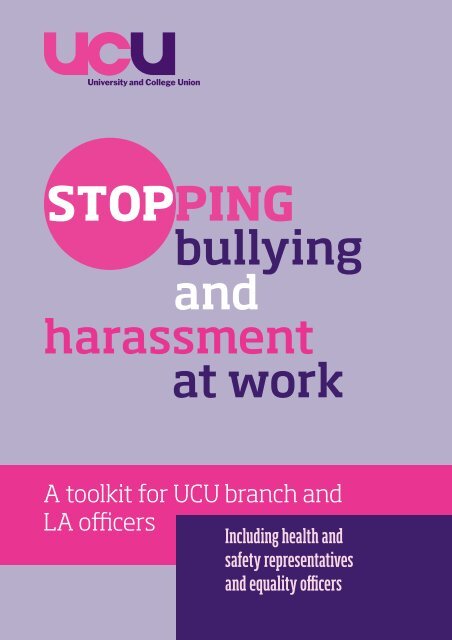

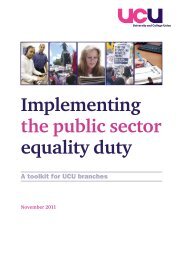

![(.pdf) [29kb] - UCU](https://img.yumpu.com/50914942/1/184x260/pdf-29kb-ucu.jpg?quality=85)







